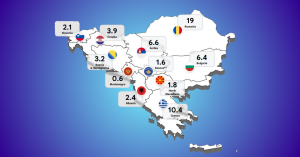I am an angel investor with more than 35 angel investments in early stage startups, and I’m also a venture partner at Innovation Endeavors. I was a scout for an early stage fund and ran several syndications with other angels.
I often get asked by startup founders which numbers/KPIs (Key Performance Indicators) investors care about and what are the numbers that drive investors to invest or not. In this article I will review some of the numbers I look at and give insight into how I evaluate these numbers. This article is intended for seed and pre-seed startup founders, but I hope that round A or even B startup founders will find it useful.
Before I start I want to emphasize that numbers are not everything, there are a lot of other attributes that investors look at when deciding if to invest in a company. For example, as I see it, the team’s ability to build and launch an amazing product, together with my ability to help them do that, is the top consideration when I look at investments in early stage startups. I also want to note that this article will focus on my experience doing B2B SaaS and developer tools early stage investment, other verticals and stages might be totally different.
So, without further ado, let’s dive into the numbers and KPIs that I evaluate when looking at an investment:
Startup KPIs
1) Engagement — Who is their Ideal Customer persona? Why do they use the product? What is the ideal usage pattern? How many of the customers are using the product that way? Does the usage grow inside the customer organically or do you need customer success?
I try to see that the founders have a good sense of their customer persona, their motivation, their needs, the value that the startup brings. I also notice if the founders know their numbers or they are just guessing or in the dark.
2) Growth — How many customers does the startup have? How fast are they growing? What is the Customer Acquisition Cost? How do they get new customers? What are the levers they have to get more users? Do customers bring other customers? Is the product more valuable as it grows?
I try to gauge if the founders understand their go to market. Many founders think about their current 2–5 customers but do not think deeply about the next stage in their go to market. Serial entrepreneurs know that product is important but the go-to market is critical.
3) Churn — Why do customers leave the service? Have you talked to churned customers? Do you count inactive users as churned? What is the number one reason for customer dissatisfaction? What are you doing to prevent churn? I look for honesty and self reflection and the ability to be critical, as well as the ability to think about solutions to customer issues within the product. I want to see that the founders do not try to “sell” to themselves or to me that everything is always amazing.
Bonus 1: Magic KPI — What patterns of usage do you want to see your customers have that will ensure they will be an engaged customer and will not churn?
This is a bonus question. In many startups there is a usage pattern that indicates a healthy customer. Example would be a user that added 3 more members to their Slack team is a great indicator that they will be using Slack successfully.
Bonus 2: What is the KPI you care about the most and why?
Market/Business KPIs
1) Market Size — What is the total addressable market (TAM)? What is the serviceable available market (SAM)? What is the serviceable obtainable market (SOM)?
This is an important KPI for investors as they are always thinking about how big this company can be. There are a lot of internal conversations about “how big can this startup become?” This is also one of the areas where founders miss the most — If your startups is making software for restaurants in Austin, your total addressable market should be the restaurants (probably initially only in the USA) and not the total food industry worldwide.
2) Annual contract value (ACV)/ Revenue per customer — How much money will a customer pay? How will you charge them? Monthly/Yearly? Subscription/Consumption/Site-license/..?
I am looking for a deep understanding into customers paying habits and a realistic point of view on pricing. This also helps me understand how many customers does the company need to reach its goals.
3) Annual Recurring Revenue (ARR) — How much money does your company make today? Is it really recurring? Is it predictable? At what rate is it growing?
This is a good indicator to the total value of the company and the stage the company is in. I have seen companies in seed with $100K revenue and companies in A round without a product. It is also a good indicator to the health of the business.
4) Burn rate — How much money are you spending per month? on what? has it grown? Are you planning to grow it and how?
I am looking for the ability to control cost, but also to be able to spend wisely. You can also read about burn multipliers here.
5) Runway — how many months does the company have to be able to run with not further investment?
I am looking for the ability to calculate all the factors of burn rate, revenue, prior investments and debt, and to realistically predict the runway.
Prior Investment Numbers
1) Current valuation — what is the last valuation of the company, if any.
2) Amount raised so far — how much money was raised by the founders and from whom (important, do not raise from jerks).
3) Cap Table numbers — Do the founders own enough of the company to successfully raise more rounds? Is there dead equity from a founder who left or an investor who took too much at the earlier round? Does the cap table represent the current stage of the company? Read more about unhealthy cap tables here.
Deal Numbers
1) Pre/Post Valuation — What is the pre-money or post-money value of the company?
This lets me know how much of the company I will own for my money (see cap and discount in SAFE later on in this section).
2) Raising Amount — How much is the company raising this time? From who? Who is leading and how much are they putting in? What is my possible allocation (how much money can I potentially invest)?
3) Cap + Discount — In case it is too early for a priced round with valuation, a SAFE might be a good option — A SAFE is a investment vehicle that has two major levers: Cap which is equivalent to Valuation in my mind, and Discount which is an additional incentive for me to invest now, rather than wait for the price round.
Every business is different and the KPI and deal numbers can be different, but these are the usual and most common numbers I look at. I want to work with founders who are data driven, that deeply understand their business and know what it takes to make it successful.
Tip for young entrepreneurs — if you do not know, do not guess. Say “I do not know, but I will find out and get back to you”.
Numbers are not everything, but they are important even for investments in early stage startups. In many cases you can tell if a deal is solid, the founders know their shit, and if the startup is heading towards the right direction from deeply talking with founders about their numbers and KPIs.
. . .
The article was originally published on Medium, by Amir Shevat.








